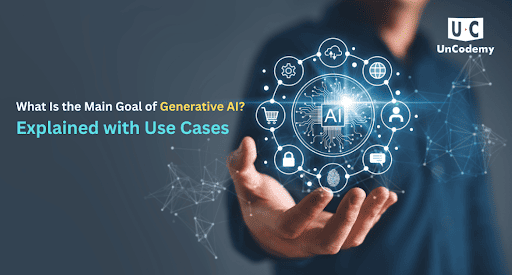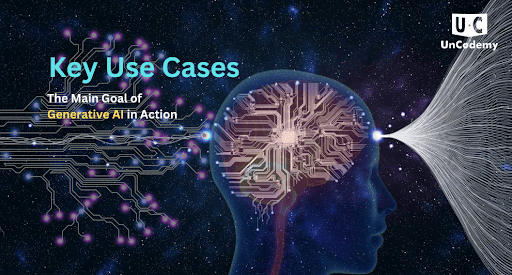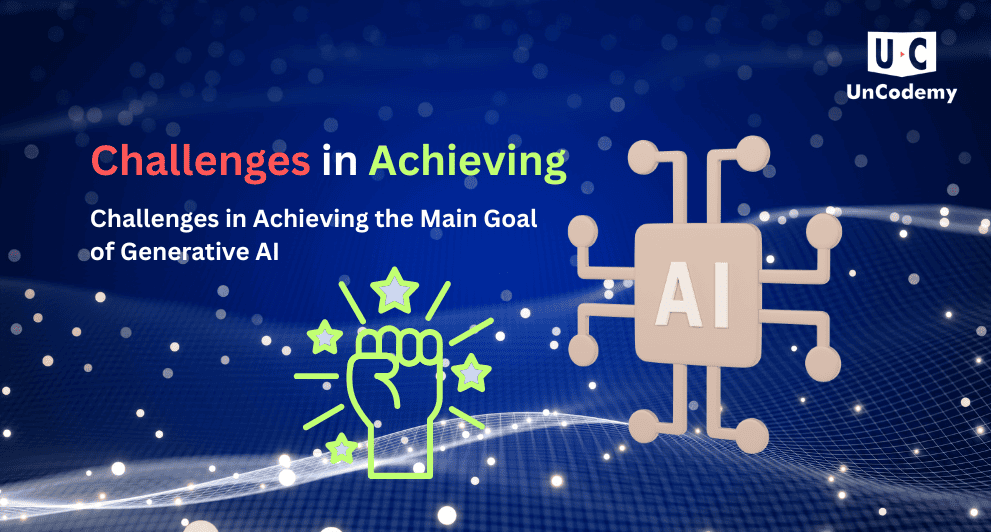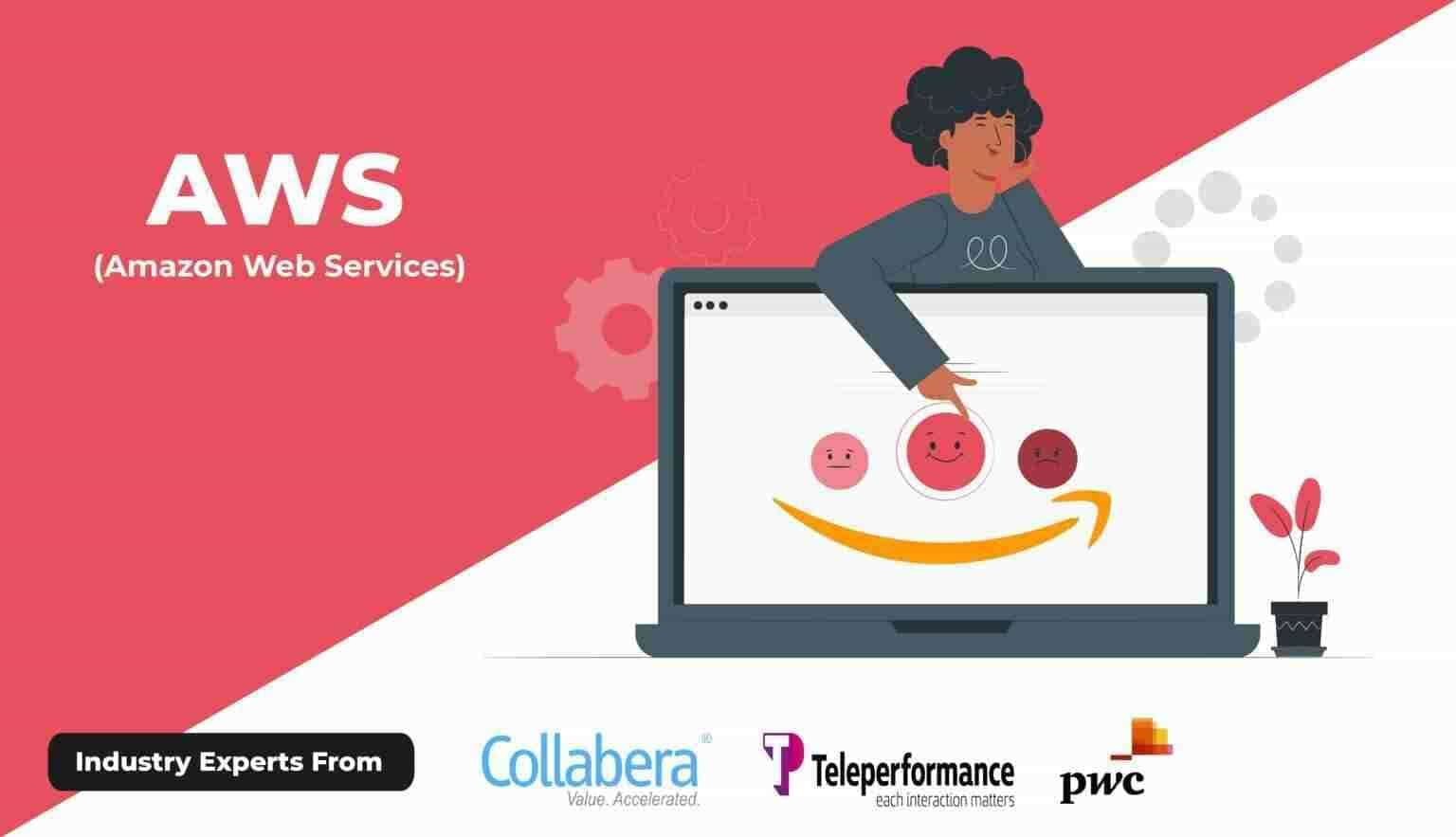What Is the Main Goal of Generative AI? Explained with Use Cases

Understanding the Main Goal of Generative AI
The goal of AI is simple, yet it is insanely ambitious: it is to create new content that mimics human-created work. Different from the traditional AI systems that primarily work on analyzing or categorizing existing data, generative AI tries to produce entirely new outputs, from texts, images, music, videos, or even code that are original, relevant, and indistinguishable from human-created content.
When taking an AI course focused on the AI generative models, you will be exposed to knowledge of systems that are designed to understand patterns in existing data and then use that understanding to generate fresh content that follows similar patterns. This is a capability that represents a significant leap forward from the earlier AI systems that could only recognize or categorize information.
The Evolution Leading to Generative AI
Reaching the current capabilities of generative AI has been a long journey, and it has been fascinating. The earlier AI systems were purely analytical and were designed to process information and make predictions based on existing data. However, as any comprehensive AI course would tell you, the field has evolved dramatically.
With major advances in machine learning techniques, particularly deep learning and neural networks, AI has gained the ability to not just analyze but also generate. The main goal of generative AI has emerged from the same evolution, to move beyond analysis and into creation.
Today, the generative AI models including GPT (Generative Pre-Trained Transformer) for text and DALL-E for images also represent the culmination of decades of concentrated research and development. These systems demonstrate how far we have come in achieving the main goal of generative AI: creating machines that can produce content that is human-like independently.
Key Use Cases: The Main Goal of Generative AI in Action

Content Creation and Marketing
One of the most widespread and visible applications where the main goal of generative AI shines through is content creation. Marketing teams around the globe are incorporating tools that can:
- Generate blog posts and articles
- Create engaging social media content
- Produce product descriptions at scale
- Draft email campaigns and newsletters
Many marketing AI courses that have come up recently now include modules specifically on using generative AI tools to enhance productivity and creativity in content creation. These tools can handle routine writing tasks, allowing human marketers to focus their time and energies on strategy and creative direction.
Art and Design
Another stunning demonstration of the main goal of generative AI comes in creative fields. AI is now able to:
- Create original artwork in various styles
- Design logos and brand materials
- Generate realistic images from text descriptions
- Produce unique music compositions
For any artists and designers taking an AI course to improve their skills, these tools offer new ways to explore creative possibilities and overcome some debilitating creative blocks. Rather than replacing human creativity, generative AI tries to heighten it by providing new starting points and different possibilities.
Software Development
Coding assistance has also become a well-sought-after application of generative AI, where its main goal is creating substantial value. Programming tools powered by generative AI can:
- Auto-complete code snippets
- Suggest function improvements
- Generate documentation
- Create basic programs from natural language descriptions
It is important for software developers to fully grasp AI because that way, they can have an edge over others in today’s competitive job market. Many specialized AI courses now focus on teaching developers how to work alongside AI coding assistants more effectively.
Healthcare Innovation
Healthcare is a critical and sensitive area where the main goal of generative AI extends beyond creativity to potentially life-saving applications:
- Generating molecular structures for new drugs
- Creating synthetic medical images for training
- Developing personalized treatment plans
- Producing realistic scenarios for medical training
Even healthcare professionals can take an AI course and often learn how these generative capabilities can complement their expertise rather than replace it. The main goal of generative AI in healthcare is to augment human capabilities and accelerate innovation.
Customer Service Enhancement
All businesses across domains are discovering how generative AI can transform customer interactions by:
- Creating conversational AI assistants
- Generating personalized responses to inquiries
- Producing detailed product information
- Crafting solutions to common customer problems
Customer service professionals and teams that are well-versed with generative AI tools can provide faster, more consistent responses while still maintaining a human-like touch. An AI course focused on customer experience often covers how to implement these tools effectively.
Beyond Creation: The Broader Impact of Generative AI
While content creation is the most obvious manifestation of the main goal of generative AI, its impact extends much further. These systems are increasingly being used to:
Solve Complex Problems
Generative AI can propose novel solutions to complex problems by generating multiple possibilities based on learned patterns. This capability is particularly valuable in fields like urban planning, climate science, and logistics.
In a specialized AI course focused on problem-solving, students learn how generative models can break through conventional thinking by suggesting approaches humans might not consider.
Enhance Decision Making
By generating various scenarios and predicting potential outcomes, generative AI helps decision-makers understand the range of possibilities they face. This application of the main goal of generative AI is particularly valuable in business strategy, policy development, and risk management.
Personalize Experiences
From entertainment recommendations to educational content, generative AI excels at creating personalized experiences tailored to individual preferences and needs. This personalization capability represents an important aspect of the main goal of generative AI: creating content that resonates specifically with each user.
Challenges in Achieving the Main Goal of Generative AI

Despite impressive advances, several challenges remain in fully realizing the main goal of generative AI:
Ethical Considerations
Important ethical concerns regarding originality, attribution, and possible abuse are brought up by generative AI. Together with technical skills, these ethical considerations should be covered in any thorough AI course.
Quality and Consistency
Even though generative AI can yield amazing results, it can still be difficult to maintain consistent quality, especially for longer or more complex outputs.
Bias and Representation
Because generative models learn from preexisting data, they may reinforce or even magnify biases in that data. Resolving this issue is essential to the development of responsible AI.
Technical Limitations
Current generative models can sometimes produce content that seems plausible but contains factual errors or "hallucinations." Overcoming these limitations remains an active area of research discussed in advanced AI courses.
Preparing for the Generative AI Revolution
How can people and organisations get ready for the revolutionary potential of generative AI? A great place to start is by enrolling in an AI course that focusses on generative technologies. These classes offer frameworks for considering how to incorporate these technologies into different workflows in addition to technical knowledge.
Before broader implementation, companies can find the most promising applications of generative AI by testing it in controlled settings. Getting practical experience with these tools can help people develop important skills for a job market that is changing quickly.
Unleashing Creativity in the Age of AI
Creating new, original content that mimics human-created work is the main goal of generative AI. For the first time, machines can’t just help us analyze and scrutinize the world but also create new content within it.
With these technologies continuing to develop, the boundary between human and machine creativity will increasingly blur and become fluid. Those who understand both the extent and limitations of generative AI will be in the best position to thrive in this landscape. Whether you’re already doing an AI course or just considering one for the future, developing this understanding may prove to be a super valuable investment.
The main goal of generative AI isn't to replace human creativity but to amplify it, providing new tools that expand what's possible and freeing human minds to focus on the aspects of creation that remain uniquely human: purpose, meaning, and genuine connection.
Frequently Asked Questions (FAQs)
Is the main goal of generative AI to replace human creators?
No. The main goal of generative AI is to augment human creativity, not replace it. These systems work best when partnering with human direction and refinement.
What skills should I focus on in an AI course to work with generative AI?
Look for AI courses that cover prompt engineering, model fine-tuning, ethical considerations, and creative applications of AI, not just technical foundations.
Can generative AI truly be creative, or is it just mimicking human creativity?
Generative AI is created by recognizing patterns in existing human-created work and generating new content that follows similar patterns. Whether this constitutes "true" creativity remains a fascinating philosophical question.
How can businesses responsibly implement generative AI?
Responsible implementation includes providing proper attribution, maintaining human oversight, ensuring transparency about AI-generated content, and regularly evaluating outputs for bias or misinformation.
Will generative AI make certain jobs obsolete?
While generative AI will transform many roles, it's more likely to change how we work rather than eliminate jobs. Roles will evolve to focus on directing and refining AI outputs rather than producing initial drafts.
How can I stay updated on advances in generative AI?
Taking an up-to-date AI course is valuable, but also follow research publications from leading AI labs, join online communities focused on generative AI, and experiment with new tools as they become available.




























